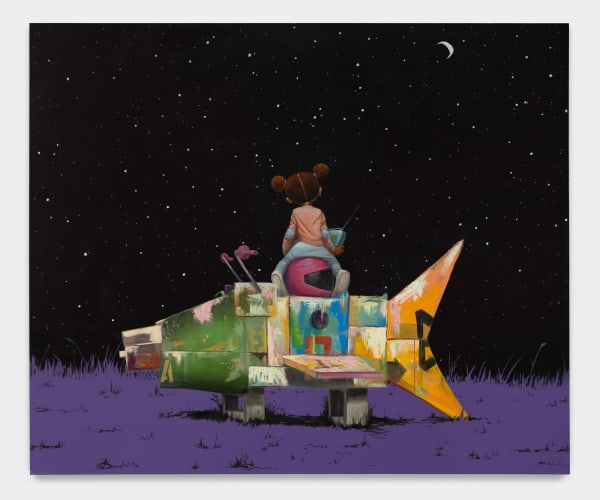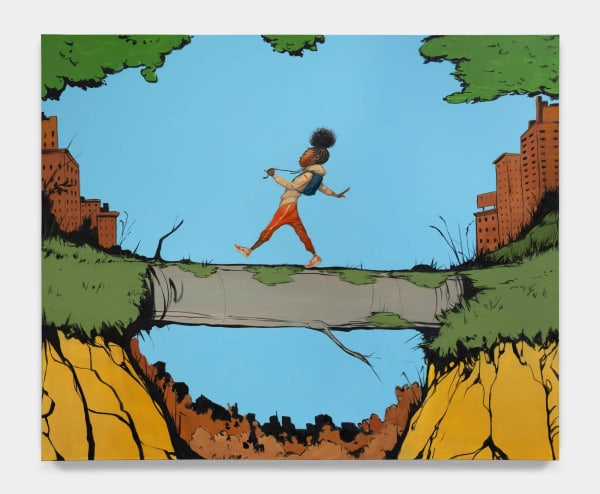Wonder World: Frank Morrison
The innocence of childhood allows our imaginations to envision futures that are larger than life. The ability to be anyone, do anything, and experience all that the world has to offer feels as if it is at our fingertips. This youthful wonder soon becomes obscured by reality. It is at this crucial moment, where we begin to lose this sense of unfettered curiosity, that Frank Morrison creates his paintings. In “Wonder World”. The collection of works challenges misrepresentations of life in black communities through a new set of imagery intended to encourage creativity and hope that is often nonexistent for these children.
The exhibition focuses on Morrison’s series of works that invite us to return to our youth. While they showcase his history as a storyteller and illustrator of children’s books, they also allow us to dive deeper into his personal journey as an artist. Growing up in the 1970s and 1980s, he watched as the icons of popular culture rarely shared the stories of those that he resembled. The color comic strips of the Sunday paper had few to no individuals of color, and when they did, rarely were they given a voice that showcased their backgrounds, families, and cultures. Superheroes, who have perpetuated symbols of justice, were exclusively white, leaving little room for young black children to aspire, dream, or envision for themselves. Nonetheless, Morrison’s admiration of comics, of both their style and influence, seeped into his work.
The influence of comics and popular culture is evident in his aesthetic choices. Within bold contour lines, he uses acrylic paint to create a flatness throughout the scene. He then interjects oil paints as he constructs the human forms, creating a dimensionality that allows them to rise from the canvas. The urban neighborhood is transformed. Using a whimsical and uplifting energy, he encapsulates the ingenious nature of the children that inhabit them, who are often overlooked. He interjects himself into the pages of the comics, creating his own harmonious diversity, and exemplifying the beauty within a colorful community.
These vibrant scenes are full of patterns and allusions to the popular culture of the time. He channels the formulas of famed Pop artists such as Andy Warhol and Roy Lichtenstein, who upended the ideas and meanings of our everyday objects and imagery. Morrison translates these into a language all his own. Mixing together Pop Art with elements of the Neo-Mannerists, iconic to his distinctive style, he tells stories that embrace the Black identity, culture, perspectives, and circumstances without falling into tropes of racism, prejudice, and subjugation that often accompany these narratives. He showcases the realms of graffiti and Hip Hop in subtle details or to create more abstract backgrounds. These references to notable Black achievements allow him to reimagine Pop Art as one that embraces the undeniable impact, rather than promoting erasure, of the imagination within Black culture. Large scale works within the exhibition envelop the viewers. They are placed among the scenes so that they can revel in the innovation unfolding around them.
Emblematic of Morrison’s exploration into the lost innocence of Black youth through this exhibition is his piece “One Day”. It is a common phrase, inspiring us to continue striving for greatness: "One day I can achieve my dreams and fulfill my desires’. It is a promise to our children, motivating them and exciting them as they find ways to foster their originality. In this painting, witnessing a young girl atop a rocket. Inscribed on its side are the names of the women who helped NASA break the boundaries of our planet, encapsulating Morrison’s hope for Black children to see themselves within the work and hold firmly to their inventiveness. The rocket, makeshift and assembled from discarded objects, is a manifestation of Morrison’s own childhood, creating imaginary worlds and mechanisms from the equipment accumulated by his grandfather. “One Day” is about making something from nothing. It is about not letting financial, societal, or systemic pressures limit your possibilities. The work, and the exhibition in its entirety, is a testament to what can happen when we nourish the imagination of our children.
The boundless optimism of youth finds itself threatened by a system that marginalizes Black communities. These systems view creativity as something that can be stolen or stifled. The struggles of the everyday lives in Black America seldom breach the media dominated, profit driven headlines, leaving the children of these communities to face the violence, poverty, and crime of neighborhoods that sometimes feel more like war zones than places to nurture our youth. Morrison dismantles the negative portrayals and neglected narratives of Black life to declare that these children’s lives deserve to be valued. Amidst the color and patterns, Morrison’s exhibition serves as a beacon of hope for children and a reminder for those who have already abandoned their dreams as adults to never surrender their brilliance or their hope.















